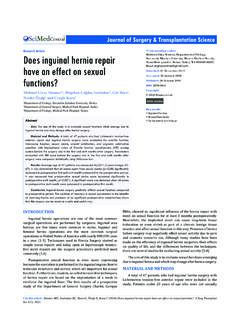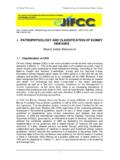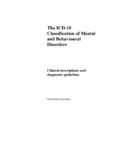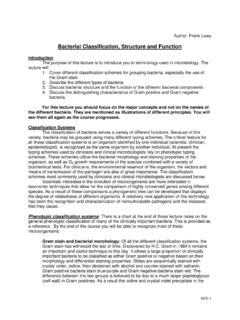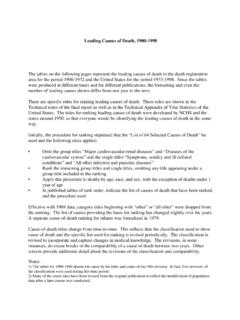Transcription of Classification and General Considerations of Thyroid Cancer
1 CentralAnnals of Clinical PathologyCite this article: Katoh H, Yamashita K, Enomoto T, Watanabe M (2015) Classification and General Considerations of Thyroid Cancer . Ann Clin Pathol 3(1): 1045.*Corresponding authorHiroshi Katoh, Department of Surgery, Kitasato University School of Medicine, 1-15-1 Kitasato, Minami-ku, Sagamihara, 252-0374, Japan, Tel: 81-42-778-8735; Fax:81-42-778-9556; Email: Submitted: 22 December 2014 Accepted: 12 March 2015 Published: 13 March 2015 ISSN: 2373-9282 Copyright 2015 Katoh et al. OPEN ACCESS Keywords Thyroid Cancer Pathological Classification Genetic alterationReview ArticleClassification and General Considerations of Thyroid CancerHiroshi Katoh*, Keishi Yamashita, Takumo Enomoto and Masahiko WatanabeDepartment of Surgery, Kitasato University School of Medicine, JapanAbstractThyroid Cancer is the most common malignancy in endocrine system, composed of four major types; papillary Thyroid carcinoma, follicular Thyroid carcinoma, anaplastic Thyroid carcinoma, and medullary Thyroid carcinoma.
2 The incidence of Thyroid Cancer , especially differentiated Thyroid Cancer , is increasing in developed countries. Growing body of studies on molecular pathogenesis in Thyroid Cancer provide clues for further research and diagnostic/therapeutic targets. The General pathological classifications and clinical features of follicular cell derived Thyroid carcinomas are overviewed, and recent advances of genetic alterations are discussed in this review. ABBREVIATIONSPTC: Papillary Thyroid Cancer ; FTC: Follicular Thyroid Cancer ; ATC: Anaplastic Thyroid Cancer ; MTC: Medullary Thyroid Cancer ; PDTC: Poorly Differentiated Thyroid Cancer ; DTC: Differentiated Thyroid Cancer INTRODUCTIONT hyroid Cancer is the most common malignant disease in endocrine system and is rapidly increasing in incidence [1].
3 The increasing incidence partially reflects earlier detection of small asymptomatic cancers because of prevalence of screening ( , small papillary cancers). However, the incidence has also increased across all tumor sizes and stages [2]. Most of Thyroid cancers show biologically indolent phenotype and have an excellent prognosis with survival rates of more than 95% at 20 years although the recurrence or persistent rate is still high [3]. The incidence of Thyroid Cancer is about three to four times higher among females than males worldwide, ranking the sixth most common malignancy diagnosed in women.
4 Thyroid Cancer can occur at any age but it is rare in childhood. Most tumors are diagnosed during third to sixth decade of life. Most primary Thyroid cancers are epithelial tumors that originate from Thyroid follicular cells. These cancers develop three main pathological types of carcinomas: papillary Thyroid carcinoma (PTC), follicular Thyroid carcinoma (FTC) and anaplastic Thyroid carcinoma (ATC). Medullary Thyroid carcinoma (MTC) arises from Thyroid parafollicular (C) cells.
5 A histologic Classification of Thyroid tumors is shown in (Table 1) [4,5]. PTC and FTC are categorized as differentiated Thyroid Cancer (DTC) because of well differentiation and indolent tumor growth. PTC consists of 85-90% of all Thyroid Cancer cases, followed by FTC (5-10%) and MTC (about 2%). ATC accounts for less than 2% of Thyroid cancers and typically arises in the elder patients. Its incidence continues to rise with age. The mechanism of MTC carcinogenesis is the activation of RET signaling caused by RET mutations [6], which are not observed in follicular Thyroid cell derived cancers.
6 Accordingly, this review mainly focuses on follicular Thyroid cell derived cancers. The classic treatment for Thyroid Cancer is conventional thyroidectomy, in part of cases, with adjuvant radioiodine ablation, and most patients can be cured with these treatments. On the other hand, surgically inoperative recurrence, refractoriness to radioiodine in DTC, poorly differentiated Thyroid carcinoma and ATC are still lethal diseases. The recent substantial developments in understanding molecular pathogenesis of Thyroid Cancer have shown promising treatment strategies.
7 In this review, we discuss General pathological characteristics of follicular Thyroid cell derived cancers and some recent advancement of molecular pathogenesis. General AND PATHOLOGICAL FEATURESP apillary carcinoma PTC is a major differentiated adenocarcinoma which consists of 90% of Thyroid cancers and shows papillary proliferation pathologically. Most cases have excellent prognosis but approximately 10% of PTC patients undergo recurrences such as lymph node recurrence and lung metastasis.
8 Selecting such high risk patients is the most important challenge as well as treatment of radioiodine refractory PTC. Clinicopathologically, age>45 years, large tumor size, extra thyroidal invasion, distant CentralKatoh et al. (2015)Email: Ann Clin Pathol 3(1): 1045 (2015) 2/9metastasis, vascular invasion and poor differentiated histology are well known detrimental prognostic factors [4]. PTC is usually gray-white color and shows a variety of gross appearance such as tumors with central scar and infiltrative borders, encapsulated tumor and lesional calcification (Figure 1A).
9 Nearly half of PTCs have multifocal lesions and regional lymph node metastasis. These characteristics do not affect long-term survival [7-9]. Most of PTCs shows papillary growth pattern but nuclear features are more important diagnostic hallmark which are common in almost all cases than such growth pattern itself (Figure 1B) [4]. The nuclear appearances of PTC are clear, ground glass, or Orphan-Annie eyed [10,11]. These nuclei are larger than normal follicular nuclei and overlapping each other.
10 The nuclei contain eosinophilic inclusions and have longitudinal grooves [12]. These nuclear features are important characteristics of PTC but not specific. Indeed, chronic thyroiditis frequently shows similar intranuclear inclusions or nuclear grooves as well as follicular adenoma [4]. Several subtypes are thought to be associated with either favorable or aggressive phenotype although it is still controversial. Here, we discuss about follicular variant, tall cell variant, diffuse sclerosis variant, and solid certain part of follicular variant of papillary carcinoma (FVPTC) was classified as FTC or follicular adenoma in the past.


